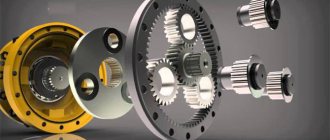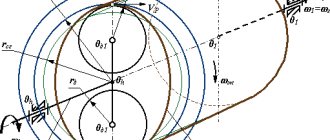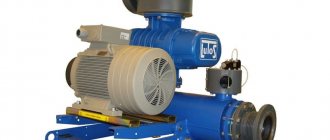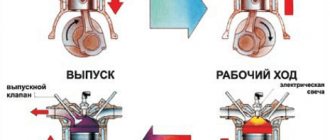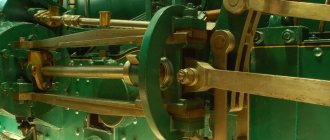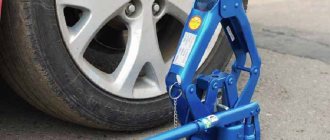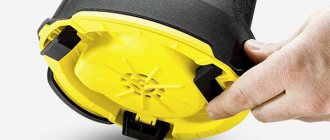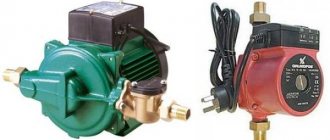Transmissions in which kinematic motion from one shaft to another is communicated due to friction between the working surfaces of rotating rollers or disks are called friction .
The components of any friction transmission are two rollers (wheels), of which one is the drive, and the second is the driven. With their outer surfaces they are pressed against each other. If the driving wheel (roller) rotates, then due to the friction force it sets the driven wheel (roller) in motion.
Like any other mechanical transmission, friction transmission is characterized by such an indicator as the gear ratio. It represents the ratio of those angular velocities that the drive and driven shafts have. Unlike many other types of transmissions (for example, gears), this indicator, by definition, cannot be constant, since the contacting surfaces of the transmission, under certain conditions, inevitably “slip” relative to each other, and therefore the transmission of motion stops for some, albeit short, time. As a rule, slipping occurs when there is an increased load on the friction transmission.
According to the criterion of the gear ratio, experts distinguish between friction gears , in which it has a conditionally constant value and a variable value. The first type includes those that consist of shafts with parallel intersecting axes, and the second type includes variators, both with and without an intermediate link.
Another technical classification of friction gears involves dividing them into closed and open. A characteristic feature of the first is that they work in a lubricating fluid, and the second - that without it. Open type friction gears are simpler in design, the clamping force of their rollers is lower, and the coefficient of friction, on the contrary, is higher. Due to the presence of lubrication, closed friction gears are more durable and less dangerous.
Friction transmissions in technology are quite widespread. They are used in drive mechanisms of belt conveyors, metal-cutting machines, foundry and welding machines.
Principle of operation
Friction transmissions consist of 2 rotating bodies: driven and driven rollers mounted on shafts. The transmission of rotational motion is carried out through the friction force that appears at the contact areas of the working bodies under the action of pressing forces. The rollers are pressed in the following ways:
- By means of hydraulic cylinders. Used during heavy loads.
- The dead weight of the machine or its component.
- Using complex lever mechanisms.
- Using centrifugal force. It is used during the movement of friction links in planetary systems.
It is important that the following condition be met: the friction force must be greater than or equal to the circumferential force. Violation of this principle leads to the occurrence of elastic and geometric sliding at the point of contact of the rotating working bodies. As a result, the angular speed of the drive roller decreases, which leads to slipping of the friction gears.
Numerous types of friction mechanisms differ in purpose, nature of change in transmission value and design. Of these, friction variators have found the greatest application in industry. They are manufactured as separate units for driving machines and are characterized by a variable gear ratio. The following types of friction variators are distinguished:
- Frontal: they have a simplified design and are used universally on screw-cutting lathes. Due to the low manufacturing accuracy of the working fluids, they wear out quickly, which reduces efficiency.
- Torus: equipped with cone-shaped disks and cups in the form of a round torus. These mechanisms ensure equality of contact stresses and increase the efficiency and wear resistance of the tool.
- Belt: motion is transmitted using a closed annular belt with different types of sections (trapezoidal, round, rectangular, V-belt). The belt is tensioned using drive motors, a pulley, a spring or a weight that acts as a counterweight.
- Disc: speed characteristics are changed by rotating two disks (clutches) located on the shafts. This type of variator does not require additional maintenance and operates with synthetic lubricant. It does not make unnecessary noise and smoothly changes the rotation speed in a given order.
The choice of a specific type of variator depends on its operating conditions: the amount of transmitted power, the required control range, and the minimum shaft speed. These characteristics are indicated when depicting the friction mechanism on kinematic diagrams.
Description
The “Bigfoot Pickup” car is made of plastic, equipped with a friction mechanism - this is a mechanism in which the cars move independently under pressure and creating a certain friction force - sliding, at an angle, using friction clutches, i.e. just press it and the car will quickly will go forward. Your baby will definitely appreciate such a gift and will be happy to add to his “vehicle fleet”!
Unemployment - (Unemployment) Unemployment is a socio-economic phenomenon in which part of the adult working population does not have a job and is actively looking for it. Unemployment in Russia, China, Japan, the USA and the Eurozone countries, including during crisis... ... Investor's Encyclopedia
Clutch (mechanical) - Clutch with diaphragm spring assembly. This term has other meanings, see Clutch. The clutch is a mechanism whose operation is based on the action of ... Wikipedia
Tractor structure - Classic type tractor Main article: Tractor The tractor consists of the following mechanisms and systems: Bearing system (Framework); The engine and its ... Wikipedia
Employment - (Employment) Employment of the population, types of employment Permanent employment, secondary and shadow Contents Contents 1. Secondary. 2. Regular and casual employment. 3. Shadow employment, partial and conditional. Employment Concept… …Encyclopedia of Investor
Differential - (Differential) Definition of differential, differential function, locking differential Information about the definition of differential, differential function, locking differential Contents Contents mathematical Informal description... ... Investor's Encyclopedia
M2 Bradley - This term has other meanings, see M2. Infantry Fighting Vehicle M2, Bradley Classification infantry fighting vehicle ... Wikipedia
M2 "Bradley" - This term has other meanings, see M2. Infantry Fighting Vehicle M2, Bradley ... Wikipedia
Winch - Winch ... Wikipedia
Press - I Irina Natanovna (b. March 10, 1939, Kharkov), Soviet athlete (track and field athletics), Honored Master of Sports (1960). Graduated from the Leningrad Institute of Engineers. D. Transport (1962). Candidate of Pedagogical Sciences (1972). Member of the CPSU since 1964 ... Great Soviet Encyclopedia
MAS-1 - (LT 1) Classification small tank/flying tank Combat weight, t 4.5 Layout diagram engine compartment in front, combat and control compartment in the middle, transmission in the rear Crew, persons. 2 History ... Wikipedia
Belarus-132N - MTZ 132n Project, 1992 ... Wikipedia
At this price you buy when you come to us for the first time.
Characteristics:
Age: from 4 years
What is the toy made of (composition): plastic.
Package size: 16.8 x 6 x 25 cm.
Toy size: 13 cm.
Description:
An interesting toy racing car for little racing fans. It is equipped with a friction motor, which makes it an inertial toy. To make her go, you just need to push her forward, which even the smallest baby can do. And the stronger the push, the greater the distance the car will travel. There are lighting effects.
Attention! The product is presented in 4 types. The price is for 1 car
Specify the desired option in the comments to the order.
Main characteristics of friction transmission
To calculate the friction transmission, the following criteria must be taken into account:
- Gear ratio is a value equal to the ratio of the number of teeth of the driven and drive shafts. It affects the speed of transmission of torque from the motor to the drive unit. This characteristic is equal to the ratio of the angular speeds of the rollers. Also, the gear ratio can be expressed using the ratio of rotation speeds or roller diameters. In most friction mechanisms its value is less than or equal to 7.
- Efficiency: indicates the amount of lost capacity. Depends on the number of losses during rolling and sliding. The value of this parameter is calculated experimentally, by comparing the powers of the drive and driven shafts. The average efficiency of friction mechanisms is 90%.
- Contact strength: characterizes the ability of a transmission to withstand large loads. It is assessed using the contact stress that occurs at the point of contact of the rollers. The lower the contact strength of the structure, the more the shape of the main parts changes during contact. This characteristic can be calculated using the Hertz formula, which takes into account the load factor, reduced radius of curvature, elastic modulus and compression force of the rollers.
- Type of movement of the rollers: characterizes the trajectory of movement of the working bodies of rotation. It can be reversible and non-reversible. During reverse movement, the working bodies of rotation move in opposite directions, which allows transmission in 2 ways. In non-reversible motion, the rollers move in one direction. Transfer is carried out in only 1 single way.
- The material of the rolling elements is a characteristic that affects the wear resistance of the device, contact strength, friction coefficient and elastic modulus. Most often, in the manufacture of kinematic pair parts, cermets or a combination of standard and hardened steel (hardening up to 60 HRC) are used. These materials reduce the dimensions of the mechanism and increase the efficiency. When using cast iron, the rollers will be able to operate without the use of lubricant. The cheapest materials are friction plastics and textolite. But they have low efficiency: 50%. Shafts with leather or wood coating have high friction values. The disadvantage of these materials is their low contact strength.
The following table shows the friction coefficient for friction gears made of different materials:
| Lubricated steel | 0,04 – 0,05 |
| Dry surface steel | 0,14 – 0,19 |
| Friction plastic with dried surface | 0,36 – 0,46 |
| Textolite with dried surface | 0,31 – 0,36 |
| Metal ceramics with dry surface | 0,29 – 0,34 |
These factors and characteristics are taken into account when depicting friction transmission on kinematic diagrams.
Backstop
This element of the reel is always in operation, be it a multiplier or a spinning reel. The mechanism is simple, but it performs a very important task - it connects the spool to the main pair, while simultaneously stopping the free movement. And, as you know, in cartoons the handle only turns forward. This is a kind of lock that transfers the force from the tensioned fishing line to the friction brake. When the stopper is turned off, the spool is released and, naturally, rotates in any direction.
There are two types of reverse stops - normal (locks after some time after turning the handle in the opposite direction) and instantaneous (locks instantly). Currently, most multipliers have an instant stop.
Shimano engineers are especially proud of their work. They even gave a unique name to their system - SuperStopper (Super Stopper - literally translated). At the moment, as the owner of a reel with just such a system, I have not had to compare it with others, but I will say objectively - it stops instantly, it does not allow even a millimeter of movement! Japanese, what can I say!
Types of friction gears
Experts identify the proper classification of friction devices:
- By the nature of the change in gear ratio: unregulated and adjustable (friction variators). The gear ratio in non-adjustable mechanisms does not change. In adjustable devices, the gear ratio is constantly changing.
- According to the method of pressing bodies of rotation: with variable or constant power. In mechanisms where shafts come into contact with variable power, auxiliary pressing devices are used.
- According to the operating conditions of the mechanisms: open and closed. Open gears only work when lubricants are used. Closed mechanisms can operate with a dry surface.
Depending on the location of the shafts, experts distinguish 3 main types of friction gears:
- Cylindrical: a mechanism with parallel shaft axes. Its planes are made in the shape of a cylinder. Used to transmit low power. This type of gear is produced with smooth, concave or convex surfaces. When using cylindrical kinematic pairs with wedge-shaped links, friction is reduced by 50%.
- Conical: a mechanism with intersecting shaft axes. Equipped with discs with a conical surface. It does not require much pressing force to function. Transmissions of this type can be either reversible or non-reversible.
- Frontal: a mechanism with a frontal surface and intersecting shaft axes. Due to intense sliding, it contains a low efficiency factor. Provides the ability to change the direction of movement and intensity of rotation of the shafts. This type of transmission is used in low-power devices.
There is a separate classification for CVTs according to the number of power flows:
- Single-flow: single-contact frontal or two-contact toroidal variators.
- Multi-flow: multi-row variators with parallel or series-parallel connection of contact pairs.
- Multi-flow closed variators.
- Multi-flow planetary variators.
This classification of the operating conditions of friction mechanisms can be used to develop general methods for calculating individual groups of gears.
Classification
The front friction mechanism is located on the spool. This design is bought mainly for spinning rods. The front clutch has the following advantages:
- strength and reliability of the brake unit;
- long service life;
- the reel weighs less;
- possibility of better adjustment;
- balance of equipment.
Flaws:
- Since the brake is installed on a spare spool, the cost of the gear increases.
- When fishing for predatory fish, it is difficult to adjust the brake on a spinning rod.
- Difficulty replacing the spool.
- Debris may get into the structure.
After the end of the fishing season, a clogged brake must be thoroughly cleaned. For cleaning, use a special fishing lubricant.
The rear friction assembly is located at the rear of the reel, behind the main assembly. The rear location of the clutch is typical for match fishing reels. They are rarely installed on spinning rods, only on cheap Chinese-made models.
Advantages of a reel with a rear clutch:
- convenient adjustment of the load when fishing for fish, since there are no unnecessary parts;
- the spare spool decreases in price;
- this design can be used with heavy baits;
- When the fishing line breaks, the loss of fish is minimal.
The rear friction brake is not sensitive. There are commercially available reel designs in which the front and rear brakes are combined. These are systems with a batrunner. There are devices that combine the rear location of the main and additional brakes. In this case, the mechanism is adjusted roughly to maximum load, and the batrunner is weakened. Thus, when a heavy fish jerks, when the front brake does not work, the rear clutch dampens the jerks of the fish and prevents the line from breaking.
Baitrunners are used for fishing when you can leave the reel with the brake on and be calm that a heavy fish will not drag the gear into the river.
The best brands of friction systems are produced by Japanese companies. They constantly release innovative models and improve the quality of products by improving their design. A friction brake will make fishing efficient and fast; rods, reels and other equipment must match the type of brake unit.
Areas of application
The use of friction gears for high power is limited due to high loads on the shafts and the presence of sliding between rotating bodies. In this case, the rollers wear out faster, which leads to their partial or complete breakdown. Friction devices are not used in mechanisms where a large number of errors in the angles of rotation of the friction links are not allowed. Otherwise, the number of unacceptable gear angles increases, leading to the appearance of slips in the contact zone of the rotating working bodies.
In industry, friction gears are used in the manufacture of forging machines and pressing equipment, transport devices, driven traction devices and machines for processing metal workpieces. In the mechanical engineering industries, friction radiators are most often used, combined with internal combustion engines or electronic motors. They allow you to continuously regulate the speed of transmission of power forces between the transmission and the drive of a car or other vehicle.
Gears with a constant gear ratio are used in the production of screw presses. In the textile manufacturing industry, they are used in centrifuges for uniform acceleration and in power drives for tensioning fibers and threads. In the woodworking sector, friction devices regulate the power of processing devices, taking into account the type of wood and the structure of the workpiece.
Clicker
This incomprehensible English (or maybe American) word is used in cartoons to describe the “ratchet”, which is familiar to the Russian ear.
The usual line-off indicator in baitcasting reels also serves as an auxiliary brake. This is nothing more than an analogue of the batrunner system installed on inertia-free vehicles. Many people are familiar with the work of a batrunner, and this article is about cartoons, so I won’t talk about this, after all, braking system. I can only say that it is turned on by a special key or switch on the side panel of the case and releases the spool from the main brake.
The clicker is especially useful for trolling fishing, as well as vertical fishing, as a bite or hook indicator. In general, this fisherman's friend helps extend the life of the reel by helping to avoid sudden loads on the main components of the multiplier.
Many users of clicker reels say that using such a mechanism is nothing more than “show-off”. But carp fishers will fundamentally disagree with this statement (I hope).
Advantages and disadvantages
The following advantages of friction gears are highlighted:
- Simple structure of mechanisms, small number of parts.
- Stepless change of speed of machine devices and machines.
- During operation, the mechanisms operate smoothly and do not produce additional noise.
- Provides the ability to reverse, enable and disable gears during the workflow.
- It has safety properties, which is due to intense slipping of mechanisms.
- When reversing, there is no backlash.
- Allows you to adjust the gear ratio on the go.
- When there is a heavy load on the rollers or shafts, the device automatically stops, which reduces the risk of accidents.
During operation, the following disadvantages of friction gears were identified:
- Open gears operating in the presence of lubrication have low efficiency.
- Low transmitted power: up to 300 kW.
- Inconstancy of the gear ratio caused by strong sliding of the links.
- When additional clamping devices and shaft supports are used, the structure becomes heavy, which reduces its mobility and increases the amount of transmitted power.
- The peripheral speed is no more than 7 - 10 m/s.
- When slipping for a long time, the shafts wear out, which can lead to malfunction of the device.
- When the rollers come into contact, colossal friction losses occur.
These shortcomings are eliminated by developing friction gears with closed pressing forces, introducing the multi-contact principle into their design, creating improved forms of rotating working bodies, pressing devices, using improved materials in the manufacture of rollers and using planetary circuits.
Tips for beginners
We hope you have mastered the basic rules for handling a friction brake, it's time for final tips:
- Collect gear according to the rules. Follow the manufacturer's recommendations: select the rod, reel and line according to the bait test. If there is a lack of experience and the use of dissimilar equipment elements, no clutch will save the fishing line or rod from damage.
- Choose branded reels. Nameless counterfeits or outright fakes are not suitable for more or less comfortable fishing. They lay the fishing line unevenly, are easily damaged, and the clutch spontaneously clamps during the fishing process.
- Remember to be adjustable while fishing. Focus on the situation: loosen the clutch when fishing very strong specimens, gradually tightening it tighter.
- Do not exceed the stated maximum. We told you how to properly tighten the brake under test fishing line, but do not tighten it even tighter - this is unsafe for the tackle. By the way, some reels cannot be tightened tightly at all - the manufacturer leaves a reserve to protect the gear.
- Leave the brake loose for storage. When you come back from fishing, put your gear in order and release the clutch - this way it will last longer.
We wish you cool weather, good catch and good gear, dear fellow hobbyists!
Nature and causes of friction gear failures
The main parameter of friction devices, which determines their wear resistance, is considered to be contact strength, assessed by the bearing stresses of the plane at the point of contact of the rollers. He identifies the following types of destruction of mechanisms for transforming movements:
- Fatigue failure. It appears in mechanisms treated with lubricants.
- Wear of kinematic pair links. Characteristic for transfers with a dried surface. Occurs when working surfaces slip, which is caused by non-compliance with the main condition for performance.
- Abrasive wear: Occurs when lubricants become contaminated with solid particles.
- Corrosive wear: occurs due to chemical exposure or oxidation of the materials of the working surfaces of the rollers. Oxidation occurs at high temperatures and insufficient lubrication. Intense oxidation can occur at low temperatures and plastic deformation of rotating working bodies.
- Surface scuffing caused by rupture of the lubricant film. Appears in high-speed systems under high loads.
The following factors of friction gear failures are identified:
- Chipping: typical for closed types of transmission working with a dried surface. Downforce increases the stress on the contact surfaces of the friction links. As a result of this influence, cracks of small volumes are formed. They are filled with lubricants, which leads to partial or complete chipping of the part and the appearance of shells on the surfaces of the rollers.
- Sticking: typical for high-speed gears. Due to heavy loads, the lubricant film breaks. At the point of contact, the temperature instantly increases, which leads to molecular adhesion of metal particles at the point of contact between the surfaces of the rollers. After prolonged exposure to high temperatures, welding of iron mechanisms occurs and the structure of the shafts is damaged. The welded parts lift up the surfaces of the rollers in the direction of sliding. Large grooves form on the working surface.
- Dispersion: occurs in certain areas of the friction surface, typical for rollers operating on boundary lubrication at moderate temperatures. The destruction of the surface layer occurs without breaking the oil film.
- Collapse (plastic deformation): appears as shiny stripes on conical disks. Due to high pressing forces and insufficient strength of the working surfaces of the transmission.
- Wear: caused by the impact of elastic sliding that occurs in the contact zone of the working bodies. Due to increased friction, parts gradually wear out, the efficiency index decreases and the gear ratio becomes inconsistent.
To prevent failure of friction devices, it is necessary to calculate the contact strength of the device. Rollers must be made of rigid materials that can withstand the highest contact forces. It is possible to prevent surface jamming with the support of extreme pressure oils. They increase the friction coefficient by 1.5 times.
The meaning of the word FRICTION. What is FRICTION?
Source (printed version): Dictionary of the Russian language: In 4 volumes / RAS, Institute of Linguistics. research; Ed. A. P. Evgenieva. — 4th ed., erased. - M.: Rus. language; Polygraph resources, 1999; (electronic version): Fundamental electronic library
Making the Word Map better together
Hello! My name is Lampobot, I am a computer program that helps you make Word Maps. I can count perfectly, but I still don’t understand very well how your world works. Help me figure it out!
Thank you! Over time, I will definitely understand how your world works.
Question: is a logothete a physical object (person, object, place, plant, animal, substance)? Can you see it, hear it, smell it, feel it, touch it?
Expressions containing "friction":
- One hit broke the sloth, and the second hit the side clutch in the stern.
- For the same reason, you cannot fish on a spinning spool with a weakly clamped clutch.
- Thus, by correctly setting (twisting) the clutch, you can avoid line breakage, loss of fish and expensive bait.
- (all offers)
Classification
Let's consider the location of the clutch on the reel and what such a device gives to the angler.
Each of the systems has the right to life and has its own positive and negative features.
The front friction brake is more sensitive than the rear.
Therefore, it is most often used for ultralight fishing:
- The adjustment is made using a special screw that secures the spool. Because of this, you have to spend a significant amount of time changing it.
- It is believed that reels with a front brake are more reliable, as they are equipped with a mechanical circuit.
- In such reels, winding can be adjusted by placing washers under the spool.
Reels with a rear-mounted friction brake differ from the previous ones in a number of parameters:
- Allows you to adjust the tackle even while fishing.
- The spool can be changed with a simple press.
- The cost of the spool is much lower.
- The clamp washer and nut are missing. When changing spools there is a risk of losing them.
The baitrunner allows you to dampen sudden jerks of the fish before hooking. After hooking, you need to switch to the front clutch.
- Such coils, together with a marker float, can be used to check the depth of a reservoir.
- Prevents the rod from falling into the water from the stand.
- The mechanism itself, due to more precise balancing, is less susceptible to vibration and operates more smoothly.
The purpose of a single rear and front clutch is to land fish after hooking. In the case of using a baitrunner, the purpose of the front clutch is fishing, and the rear clutch is to adjust the force of free rotation of the spool before hooking.
Today, models with three clutches have appeared on the fishing reel market.
- The third “fighting brake” is designed for landing large fish.
- Each of the three brakes has a different ratchet sound. Thus, it is easier for the fisherman to determine which of the clutches is working at the moment.
The prices for such reels are quite high. Before buying one, you should think about its feasibility.
